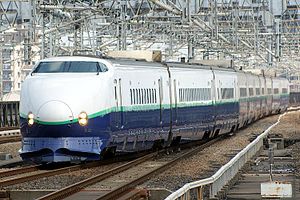| 200 series | |
|---|---|
 Refurbished 200 series trainset, July 2008 | |
| In service | 23 June 1982 – 14 April 2013 (30 years, 295 days) |
| Manufacturer | Hitachi, Kawasaki Heavy Industries, Kinki Sharyo, Nippon Sharyo, Tokyu Car Corporation |
| Constructed | 1980–1986 |
| Entered service | 23 June 1982 |
| Refurbished | 1999-2002 (K sets) |
| Scrapped | 1997– |
| Number built | 700 vehicles (66 sets) |
| Number in service | None |
| Number preserved | 4 vehicles |
| Number scrapped | 695 vehicles (of which, set K25 due to earthquake damage) |
| Successor | E1 series, E2 series, E4 series |
| Formation | 8, 10, 12, 13, 16 cars per set |
| Operators | JNR (1982–1987) JR East (1987–2013) |
| Depots | Niigata, Sendai |
| Lines served | Tōhoku Shinkansen, Jōetsu Shinkansen, Gala-Yuzawa Line |
| Specifications | |
| Car body construction | Aluminium |
| Car length | 25,000 mm (82 ft 0 in) |
| Width | 3,385 mm (11 ft 1.3 in) |
| Height | 4,410 mm (14 ft 6 in) |
| Doors | Two per side |
| Maximum speed | 240 km/h (149 mph) (275 km/h (171 mph) in past) |
| Traction system | Thyristor drive |
| Electric system(s) | 25 kV AC, 50 Hz overhead catenary 25 kV AC, 50Hz and 60Hz overhead catenary (Set F80 only) |
| Current collector(s) | Pantograph |
| Safety system(s) | ATC-2, DS-ATC |
| Multiple working | 400 series, E3 series |
| Track gauge | 1,435 mm (4 ft 8+1⁄2 in) standard gauge |
The 200 series (200系) was a Shinkansen high-speed train type introduced by Japanese National Railways (JNR) for the Tohoku Shinkansen and Joetsu Shinkansen high-speed rail lines in Japan, and operated by East Japan Railway Company (JR East) until 2013. They actually predated the 100 series trains, having been built between 1980 and 1986. It was one of the two recipients of the 23rd Laurel Prize presented by the Japan Railfan Club, the first Shinkansen type to receive that award. The last remaining sets were retired from regular service in March 2013, and were completely withdrawn from service in April 2013.